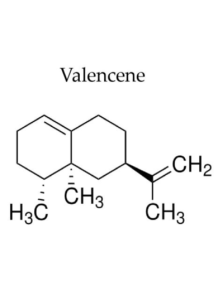Valencene
- Product Code: 35404
Valencene has been widely researched for its anti-inflammation benefits on the skin.
Valencene has been widely researched for its anti-inflammation benefits on the skin.
Valencene is a terpenes found in citrus and some strains of cannabis.
Valencene has been widely researched for its anti-inflammation benefits on the skin.
Research: In vivo and in silico anti-inflammatory properties of the sesquiterpene valencene
(Please find more detail about the research in the attached file)
This study investigated the anti-inflammatory properties of the sesquiterpene valencene (VLN) using in vivo mouse models of acute and chronic inflammation, as well as in silico molecular docking analysis. The key findings are:
1. Acute inflammation models:
- VLN (10, 100 or 300 mg/kg) administered orally significantly inhibited paw edema induced by various inflammatory agents (carrageenan, dextran, histamine, arachidonic acid) in a dose-independent manner.
- VLN (10 mg/kg) reduced leukocyte recruitment, albumin extravasation, and the production of myeloperoxidase (MPO), IL-1β, and TNF-α in carrageenan-induced peritonitis and pleurisy models.
2. Chronic inflammation model:
- VLN (10 mg/kg) administered daily for 10 days reduced the weight of cotton pellet-induced granuloma and the concentration of total proteins, indicating anti-proliferative effects.
3. In silico analysis:
- Molecular docking studies suggested that VLN can favorably interact with the cyclooxygenase-2 (COX-2) enzyme and the histamine H1 receptor, potentially inhibiting pro-inflammatory pathways.
In conclusion, this study demonstrates the potent anti-inflammatory activity of VLN in both acute and chronic inflammation models, mediated through the modulation of key inflammatory mediators and signaling pathways. The in silico findings provide mechanistic insight into the anti-inflammatory effects of VLN, suggesting its potential therapeutic applications, particularly in the development of topical anti-inflammatory formulations.
Research: Inhibitory Effect of Valencene on the Development of Atopic Dermatitis-Like Skin Lesions in NC/Nga Mice
(Please find more detail about the research in the attached file)
This research article investigates the inhibitory effects of valencene, a compound isolated from the rhizomes of Cyperus rotundus, on the development of atopic dermatitis (AD)-like skin lesions in NC/Nga mice. The key findings are:
1. Topical application of valencene significantly reduced AD-like symptoms such as erythema, scarring, edema, and scratching behavior in DNCB-sensitized NC/Nga mice. It also recovered the decreased expression of the skin barrier protein filaggrin.
2. Valencene treatment decreased the levels of serum IgE and proinflammatory cytokines IL-1β, IL-6, and IL-13 in skin and spleen tissues of DNCB-treated mice.
3. In vitro, valencene inhibited the expression and secretion of Th2 chemokines (TARC/CCL17, MDC/CCL22) and proinflammatory chemokines (CXCL8, GM-CSF, I-CAM) in TNF-α/IFN-γ-stimulated HaCaT keratinocytes. This was mediated through the blockade of NF-κB activation, but not STAT1.
4. Valencene also increased the expression of the skin barrier protein involucrin in HaCaT cells.
5. In LPS-stimulated RAW 264.7 macrophages, valencene suppressed the production of proinflammatory cytokines IL-1β and IL-6.
In summary, the study demonstrates that valencene has potent anti-atopic effects by 1) reducing inflammation, 2) enhancing skin barrier function, and 3) modulating both keratinocyte and macrophage responses. These findings suggest that valencene could be a promising natural therapeutic option for the treatment of atopic dermatitis.
Usage: For all kinds of cosmetics
Mixing method: Mix in other types of oil (oil-phase) or emulsifier with a pH range of 4-7.
Rate of use: 0.1-0.5% (recommended 0.5%)
Product characteristics: Liquid oil, opaque and clear, colorless or light yellow.
Solubility: Can dissolve in oil And alcohol
Storage: If you want to keep long-term Keep in the refrigerator Temperature between 4 ° C -8 ° C Be at least 24 months old
INCI Name : Valencene
| Mechanism | - |
| Appearance | - |
| Longevity | - |
| Strength | - |
| Storage | - |
| Shelf Life | - |
| Allergen(s) | - |
| Dosage (Range) | - |
| Recommended Dosage | - |
| Dosage (Per Day) | - |
| Recommended Dosage (Per Day) | - |
| Mix Method | - |
| Heat Resistance | - |
| Stable in pH range | - |
| Solubility | - |
| Product Types | - |
| INCI | - |
Purchase History for
Cart
No products



